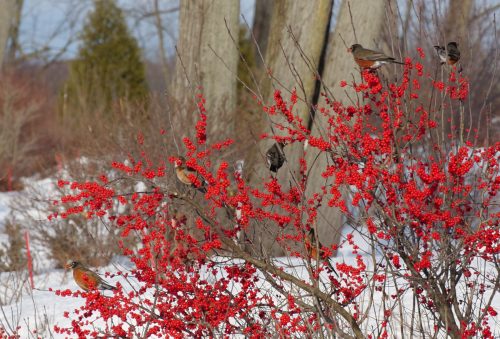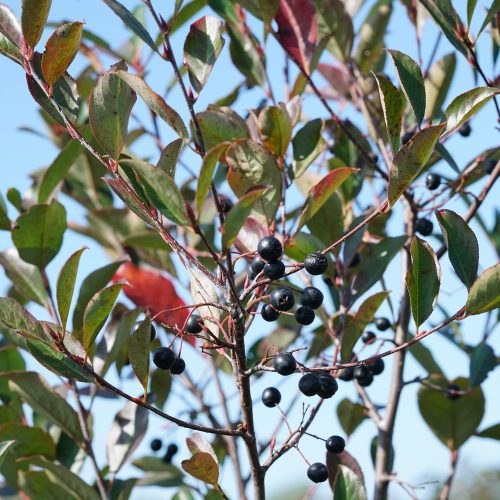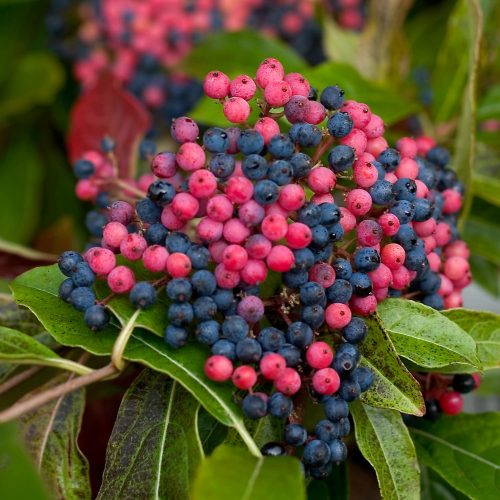
It’s no coincidence that shrubs tend to produce their berries in late summer and fall rather than in the spring. One reason is because plants and birds have coevolved to benefit one another. Fall berries tend to be high in antioxidants which help to reduce the stress and inflammation that birds experience during their migration south. They can eat as much as three times their body weight in fruit each day this time of year.
Plants need a way to disperse the seeds they produce. Birds help them out by eating their berries and excreting or regurgitating the seeds they contain. The nitrogen birds excrete along with the seeds helps them grow. Some seeds that require scarification to germinate are aided by the birds’ digestion process. It’s a win-win situation for both the birds and the berry-producing plants.
Even if you live in a very cold climate, there are lots of berry-producing shrubs you can grow to provide food for the birds in your neighborhood. We’ll show you several shrubs with berries for birds below. Some shrubs require a second plant nearby for pollination to occur and berries to form. That detail is noted for each plant described below.
A note about hardiness zones — These numbers represent the coldest temperatures in which a plant can survive the winter. The lower the number, the colder your climate is. If you live in USDA zone 3, plants that are rated for zone 3 or lower will survive your winter, but those rated for zone 4 and higher will not.
Zone 4 Hardy Berry Producers
A somewhat milder winter allows these zone 4 hardy (down to -30°F) shrubs to feed the birds from mid to late summer and into the fall months.
Lemony Lace® is a selection of our native elderberry which can produce clusters of small, bright red fruits in late summer or fall without a second pollinating shrub nearby. The red fruits are easy to spot against the backdrop of chartreuse-yellow foliage. Cardinals, bluebirds, robins, grosbeaks, tanagers, goldfinches, cedar waxwings, house finches and other birds all enjoy elderberry.
Viburnum shrubs are also particularly attractive to birds who use their dense foliage canopy for shelter and their berries for food. Red Balloon® bears large, showy clusters of fire engine red berries in late summer and fall. It will develop some berries without a pollinator, but you’ll get more fruit if you plant a ‘Mohican’ or ‘Alleghany’ viburnum nearby. Native arrowwood viburnums All That Glitters® and All That Glows® serve as pollinators for one another and can both produce abundant crops of blue fruits in the fall.
The hardy and durable Gin Fizz® conical juniper was selected for its copious crop of silvery blue berries that appear without a pollinator. Standing 10 to 18 foot tall and spreading 7 to 10 foot wide, it makes an outstanding screen or windbreak for sunny landscapes. It is drought tolerant, deer resistant, and its stems work beautifully in winter arrangements.
Also hardy to zone 4 is Sky Dew™️ Gold northern highbush blueberry. Though it does produce tasty berries for both you and the birds in late summer if a compatible pollinator is nearby, this variety is grown more for its ornamental foliage. Bright chartreuse-gold leaves shine in spring and summer before transitioning to brilliant orange and red tones in the fall. Think of it as an alternative to burning bush that’s good for both you and the birds.
Zone 5 Hardy Berry Producers
If you garden in zone 5 (down to -20°F), you will be able to grow all of the berry-producing shrubs described above plus those shown below. Your neighborhood birds will have a feast!
Blue holly isn’t just an iconic plant to use for decorating around the holidays. Its berries are also a favorite of robins, thrushes, cedar waxwings, bluebirds and northern mockingbirds. Use as many of the berried branches as you’d like for Christmas, then leave the rest of the berries for the birds. Once they soften, they will be snatched right up.
Deciduous holly, also known as winterberry, is also great for providing sustenance for your neighborhood birds. It is hardy to zone 3, whereas you’ll need to garden in zone 5 or warmer to grow evergreen blue holly. All require both male and female hollies to be present for pollination to occur and berries to form.
While cotoneaster berries aren’t edible for humans, they are often one of the first fruits snapped up by robins, thrushes, cedar waxwings and blackbirds. Little Dipper® cotoneaster produces a generous crop of red berries in the fall without a pollinator nearby. They decorate its spreading branches. Use this shrub like a groundcover that grows just under a foot tall but spreads three feet.
Brandywine™️ produces one of the most stunning berry displays of all viburnums. Its large clusters appear in late summer packed with bright pink fruit that transitions over to inky blue. They persist into winter and complement the glossy, deep burgundy fall foliage. Moist soil and some sun are needed to see a good berry show from this shrub; no pollinator is required.
For sheer quantity of fall berries, plant Pearl Glam® beautyberry (Callicarpa). Though the individual berries are small, they appear by the thousands in clusters up and down the stems of this remarkable shrub every fall. No pollinator is needed to set fruit. Pearl Glam has the added bonus of purple-tinted foliage to complement the berries. This shrub’s stems are fun to use in bouquets, and it makes an interesting centerpiece for combination containers.
You might know elderberry for its medicinal properties, but they’re also great shrubs with berries for birds. They are wonderful for attracting birds into your garden. While Lemony Lace elderberry (described above) is a selection of a zone 4 hardy species, the popular Black Lace® elderberry is hardy in zones 5 through 7. It produces large clusters of black berries in late summer to fall if a suitable pollinator like Laced Up® or other Sambucus nigra is planted nearby. The fruit is often quickly snapped up by numerous species of birds which enjoy elderberry.
Want to explore more of our shrub offerings? Tap here.


